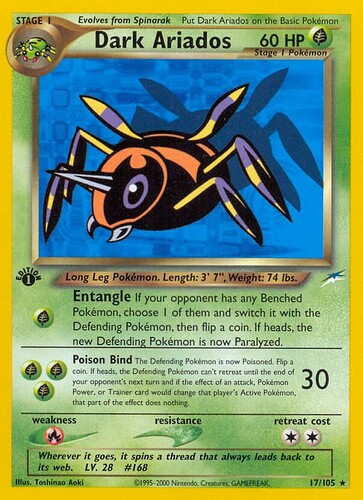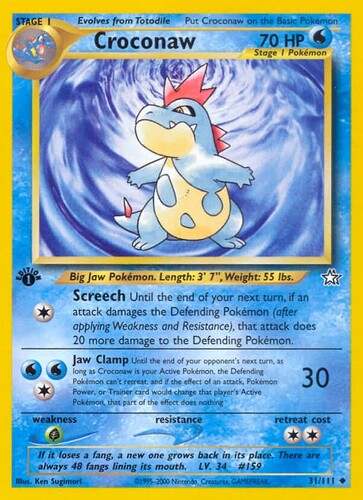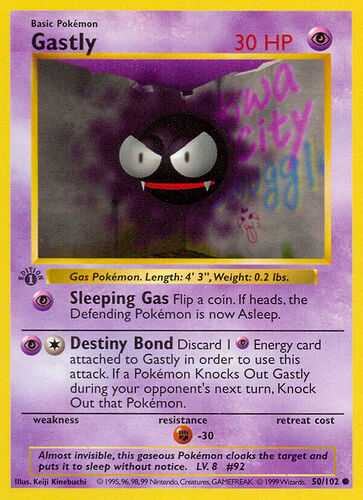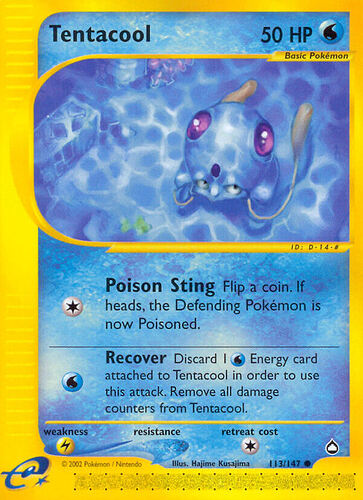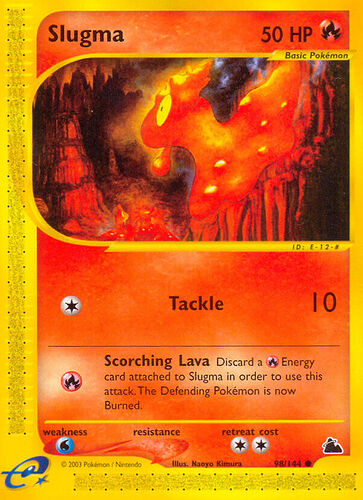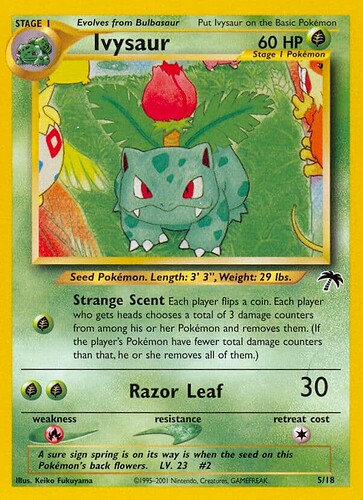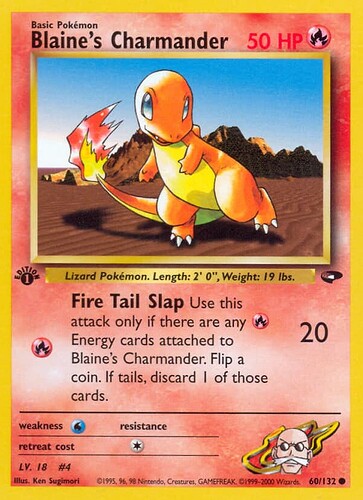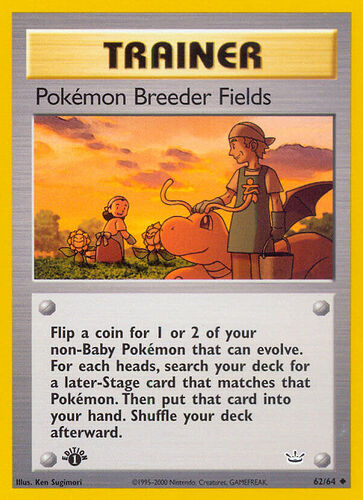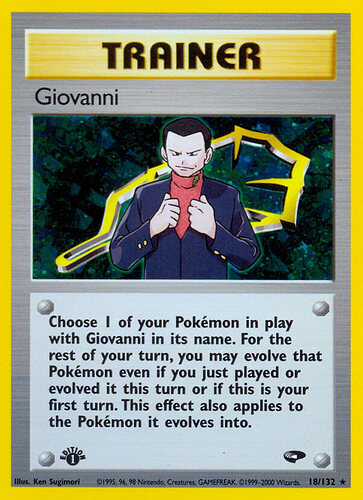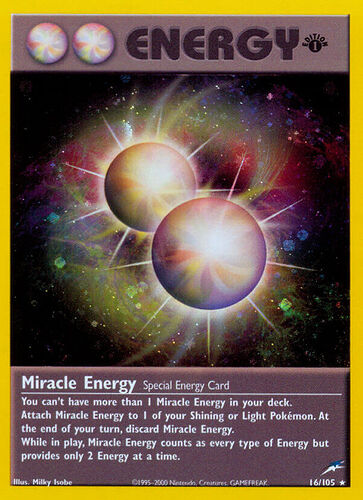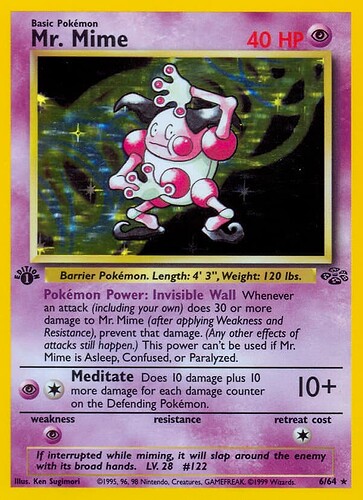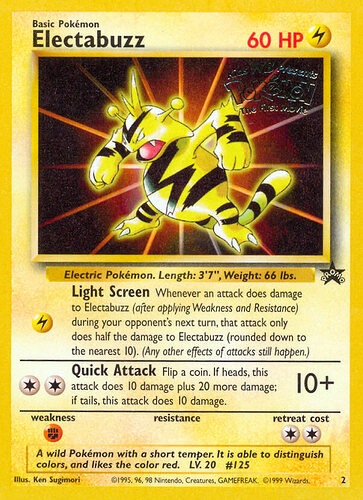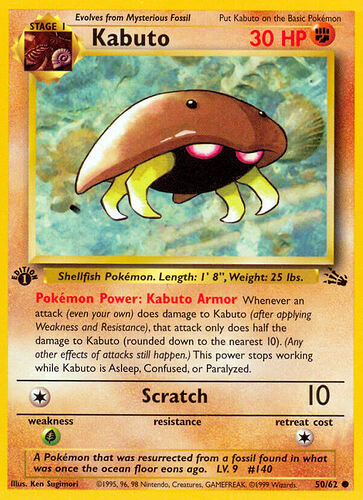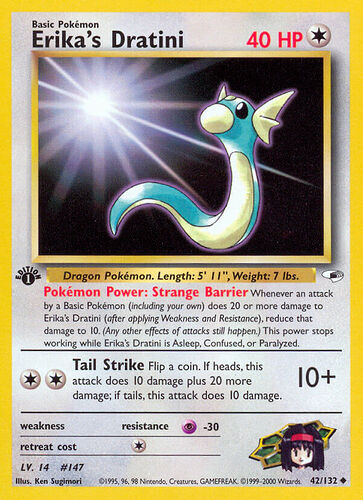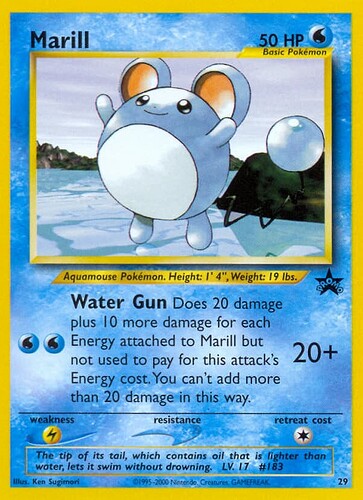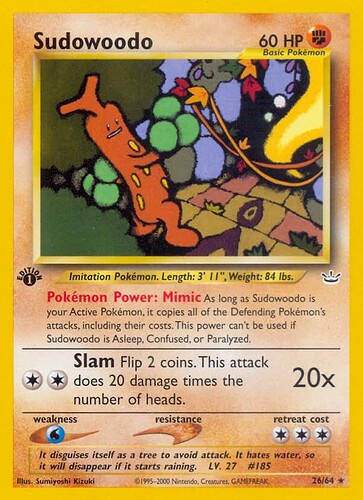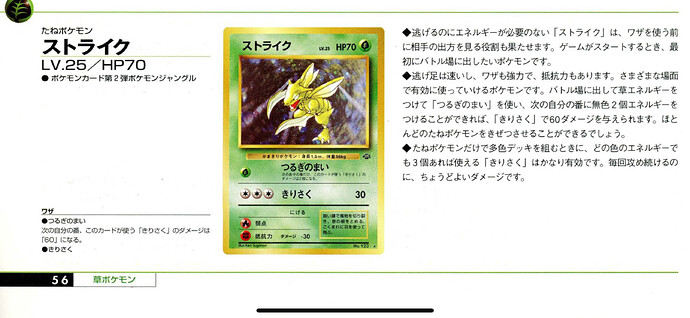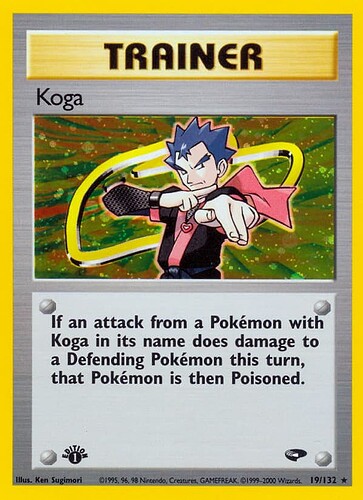Mewtwo should not say “another” in the first attack which would matter if you want to attack but not have anything happen.
The switch preventing attacks of these cards should not be limited to attacks powers and trainers. This matters in neo-skyridge because of warp energy.
I think destiny bond should trigger regardless of what knocks it out. Like dark crobat would also trigger it. When it does it knocks out the opponent’s active
These cards should not require discarding in order to use their effect. Most of the cards in the same formats as these cards were mistranslated in a way that makes the interaction actually the same but togetic n1 and promo togepi were not and interact differently with these cards between english and japanese. Flareon sk has the same problem but I think can’t come up in any format but unlimited
I think this should actually be up to three same with vileplume si17 though not all of the cards from the same set?
These cards should be usable without the energy but fail if you can’t discard the energy required
Breeder fields should not be able to search for a stage 2 from a basic
You have to do he first evolution immediately. This also means if you copy giovanni with chaos gym you can evolve one of your own giovanni pokemon.
Miracle energy should unattach at the end of the turn even if its attached on the opponent’s turn. This matters in neo skyridge because of tentacruel aq (also applies to aqua and magma energy)
These cards should prevent/reduce any damage, not just damage from attacks.
Another issue with strength charm: It gets discarded after the pokemon its attached to attacks regardless of if it deals damaged. This is correct on tcgone but when it happened to me I didn’t realize there was a mistranslation
This marill should only increase with extra water energy, not any energy
Pineco :
Japanese text:
自分 にも40ダメージ。おたがいの控えポケモン全員にも、「弱点・抵抗力」に関係なく、それぞれ10ダメージ。コインを投げて「うら」なら、このワザは失敗する。
There is no first coinflip. It’s mandatory.
It could translate to:
This Pokémon also does 40 damage to itself. This attack also does 20 damage to each Benched Pokémon (both yours and your opponent’s). (Don’t apply Weakness and Resistance for Benched Pokémon.) Flip a coin. If tails, this attack doesn’t happen/does nothing (not sure which one is the correct translation as even TPCi failed to translated such thing)
Thanks for all the work you spent translating! Before we get ahead ourselves, let me clarify an important distinction. There’s a difference between mistranslations and erratas.
Just as the English text of the game’s oldest cards was often vague or straight-up wrong, original Japanese cards suffered from these same problems. And while sometimes the differences spotted in English cards were because of translation errors, other times, these differences were made intentionally to clarify Japanese text.
As one specific example, the Japanese text for Pokémon Tower does not mention Energy cards. Nonetheless, the card was ruled in Japan to affect Recycle Energy. In Japan, Pokémon Tower was out before Recycle Energy, so there was no need to reference Energy cards. However, the game’s creators wanted its effect to apply to everything and made this ruling.
Because of this, when we look at attacks like Destiny Bond in Japanese, even though the literal translation in Japanese may seem to indicate that any type of KO triggers its effect, it’s important to understand that this may not actually be its intended function. It’s very possible the English print was clarifying this based on a Japanese ruling. Before we issue erratas, we first verify with official Japanese ruling guides from the era. When we cannot find an applicable ruling, our next best guess it to ask Japanese players who played during that era to clarify. And only when we are confident that the English text is wrong do we issue our unofficial TCG ONE erratas. @CoconutLaCroix has become an expert researcher in these kind of rulings. Maybe he can help us out here! ![]()
I want to echo Jason’s thanks here, to everyone who’s been contributing, especially byvci. I haven’t been so active in the Pokémon sphere lately due to other obligations, but I’m glad to see these things getting discovered and documented.
Regarding Gastly’s Destiny Bond, byvci is right. The clarified text in the Silver Bible states that, during your opponent’s next turn, if this Pokémon (Gastly) is knocked out while in the battlefield (aka active position), then your opponent’s active Pokémon is knocked out as well. See the Japanese old back wiki for more info.
You flip the coin first for Pineco’s attack. If it’s tails, the attack does nothing. If it’s heads, the attack does 40 damage to the opponent’s active Pokémon, 40 damage to itself, and 10 damage to each Pokémon on each player’s bench. The only error in WotC’s translation is that they accidentally said “flip a coin” twice. The “if tails, this attack does nothing” bit at the end should be referring to the first coin flip.
We finally have confirmation that Stantler’s Terrorize does not work on baby Pokemon:
First off, it’s great to see that long-standing question answered with some confidence.
Second, I’ve long dreamed of an English equivalent of the Japanese old-back wiki. Does anyone have experience running websites such as that? I’d love to help create a unified, comprehensive resource for retro rulings, translation fixes/clarifications, etc., but though I may have the knowledge and passion for Pokémon research, I don’t know anything about creating a website/wiki/whatever.
Sudowoodo n3 english text seems to imply that it functions like sabrina’s alakazam (whose attacks can be shut off with poliwhirl bs) which I think is not the case.
Alakazam e1 english text seems to mean you use the power when you attack but in japanese can use the power at any time which allows it to copy attacks that turn. I think this would mean for example in 2004 it could use the power, then reversal a slaking rs and still copy an attack.
I agree on the first point.
Sudowoodo:
- このカードは、バトル場にいるかぎり、相手の対戦ポケモンの持っているワザを使うことができる。そのワザに必要な「エネルギー」がこのカードについていないときや、このカードが「ねむり・マヒ・こんらん」状態のとき、この力を使うことはできない。
- As long as this card is in the active spot, it can use any attack that the opponent’s active Pokémon has. You cannot use this power if this card does not have the Energy needed for the move, or if this card is Asleep, Confused, or Paralyzed.
Sabrina’s Alakazam (Bible Text):
- 自分の場にいる「超」ポケモンが持っているすべてのワザを、このカードも持っているものとする。(それらのワザを、このカードのワザとして使うことができる)。このカードが「ねむり・マヒ・こんらん」状態のとき、この力は消える。
- All attacks that your “Psychic” Pokémon that you have in play have shall also be on this card. (You can use those attacks as this card’s attacks). If this card is in Sleep, Paralysis, or Confuse, this power disappears.
Poliwhirl:
- 相手のワザを1つ選ぶ。次の相手の番、そのポケモンは、そのワザを使えない。
- Choose one of your opponent’s active Pokémon’s attacks. On your opponent’s next turn, that Pokémon cannot use that attack.
Since Sabrina’s Alakazam’s power says that it has all of the attacks of all of your Psychic Pokémon in play, Poliwhirl is able to disable the use of those attacks, as they are considered to be Sabrina’s Alakazam’s attacks. Sudowoodo, in contrast, is able to use the opponent’s active Pokémon’s attacks, without treating them as if they were Sudowoodo’s own attacks. For this reason, Poliwhirl should not be able to prevent Sudowoodo from using any of those attacks.
As for the second point, regarding Alakazam (e1), I’m less confident.
Alakazam (e1):
- この力は、自分の番ごとに1回使うことができる。この番の終わりまで、相手の場のポケモン全員の持っているワザを、このポケモンの持っているワザとして使うことができる(そのワザに必要な「エネルギー」が、このポケモンについていないなら使うことはできない)。このポケモンが「特殊状態」のとき、この力を使うことはできない。
- This power can be used once per your turn. Until the end of this turn, you can use any attack that any of your opponent’s Pokémon have as this Pokémon’s attack. (If the Energy needed for that attack is not on this Pokémon, you cannot use it.) This Pokémon cannot use this power when it is in a “Special State”.
Slaking:
- このポケモンがバトル場にいるかぎり、相手のポケモン全員は、ポケパワーを使うことができない。
- As long as this Pokémon is in your active spot, none of your opponent’s Pokémon can use their Poké-POWER.
The “once per turn” and “until the end of this turn” clauses do seem to imply that the power is placing an effect, which persists until the end of the turn in which it is used, allowing it to use any of the opponent’s Pokémon’s attacks on that turn. The effect is placed on Alakazam, so bringing up one of the opponent’s benched Pokémon should not break that effect. However, suppose you bring up your opponent’s Slaking, as byvci suggested. Slaking’s Poké-BODY states that, as long as it’s active, the opponent’s Pokémon can’t use any Poké-POWERs. What happens if Alakazam has already “used” its Poké-POWER prior to gusting up the Slaking? Does the effect of being able to use the opponent’s Pokémon’s attacks still persist until the end of the turn? I can’t (yet) say for certain. I’ve been flipping through books and archived webpages looking for a ruling, but I haven’t found one yet. I can say that, according to one Japanese old-back player, Base Set Charizard’s Energy Burn was not meant to work this way. That is, if you use Energy Burn to turn your (non-Fire) Energy to Fire type, and then do something like devolve (via Devolution Spray), shut off the power (via Goop Gas Attack), or move the energy elsewhere (via Charmander TR’s Gather Fire), then the energy should turn back to their original color, despite the “until the end of this turn” clause in the text. However, the specific reasoning behind this was not clear, and the player was not fully confident in that interpretation, which was based mainly on GB2 functionality.
There is a dp era ruling (last result of this search) which seems to suggest the effect would persist but brock’s ninetales losing its power does cause it’s ability to stop. I can’t find a ruling for e-card/ex. There might be a distinction between goop/magby/fossil muk which make a pokemon lose powers vs slaking/muk ex which just say you can’t use the powers (the japanese text of muk ex says you can’t use powers but muk fo says you can’t use them and the pokemon lose them)
Edit:last ruling of this search seems to contradict the ninetales ruling?
Eidt2:nvm I can’t read
It took me a bit to notice, but the reason those two rulings are different actually has nothing to do with the Pokémon—it’s because the Porygon-Z ruling uses Crystal Shard, which turns the Pokémon’s type to Colorless, while the Ninetales ruling uses Cessation Crystal, which shuts off Powers and Bodies. Based on the wording of the two Pokémon’s powers, each ruling would be the same if they involved the same tools.
This is just my opinion, but I think the Alakazam → Pokémon Reversal → Slaking scenario is different enough from the Porygon-Z/Ninetales + Cessation Crystal scenarios that I wouldn’t really feel comfortable applying the latter rulings to the former. To me, it seems more likely to be a case of strange wording leading to unintended vagueness and potentially bizarre interactions. Thankfully, it’s niche enough that I don’t think it’s likely to come up often—if ever. Even so, in the name of knowledge, I’d love to know how PCL would have ruled it.
Several cards have inconsistencies related to “base damage”. Jungle scyther recieved this english ruling:
Q. If Ditto is copying Scyther and does Swords Dance, and your opponent retreats his Scyther to bring up a different Pokemon (say, to remove Poison), then switches that new one again with the Scyther, does Ditto lose the advantage of Swords Dance? And if so, is it because there is a Ditto-as-something-else between the two Ditto-as-Scyther stages?
A. The effect is still there, but unless Ditto’s new form has Slash for 30, he cannot make use of it. For example, if Scyther retreated for Parasect, the Ditto-as-Parasect’s Slash will do 60 if previously ‘Danced’ as a Scyther (Direct from R&D, folks). If the Slash does NOT have a base damage of 30 (such as Sandslash’s Slash attack) then the Dance will not affect it. (4-6-00 WotC Chat Q47)
The japanese text of scyther says that the base damage is just set to 60 rather than replacing 30 with 60. (Printed text says the damage is doubled but it got an errata). If the ruling is correct about different “slash” attacks getting bonus damage (idk if it is) then the original damage shouldn’t matter.
Lt. Surge’s rattata g1 should set to 40 rather than double lt. Lt. Surge’s raticate g2 should set to 80 and 40. (They got errata)
Heracross n1 should set to 120 rather that 120 from 60. Koga’s ditto’s damage increase is part of pound’s text rather than giant growth. Rocket’s scizzor should set the damage to 40 rather than doubling it. And its not wotc but pelipper rs should increase damage by 40 rather than set it to 70/60.
True! Scyther’s silver bible text simply states:
During your next turn, if this card uses “Slash,” its damage becomes 60.
In the case of a Ditto using Slash, I believe that the Swords Dance effect should remain in effect and change the Slash damage to 60 if it uses an attack called Slash on the following turn, even if it’s no longer transformed into Scyther.
List of old back Pokémon with the きりさく (Slash) attack:
- Charmeleon BS
- Dugtrio BS
- Parasect JU
- Scyther JU
- Blaine’s Charmander
- Pinsir (Vending)
- Gligar N1
- Kabutops N2
- Scizor N4
- Croconaw (Intro Pack Neo)
Based on the Silver Bible wording of Swords Dance, a post-SD Ditto should deal 60 with Slash if it’s transformed into any of these.
In pre-bw formats ancient ruins should check for a supporter card in play so you can use it if you played a supporter and it got stopped by chaos gym/slowking n1
この番に、「キョウのポケモン」が、ワザによって相手の対戦ポケモンにダメージを与えたら、ダメージを受けたポケモンを「どく」状態にする。
If I am understanding the japanese text correctly if you play Koga and your opponent uses it with chaos gym the poison shouldn’t happen. A contrived example of how this could matter is you want to get koga out of your hand to play mail from bill but don’t actually want the poison so you can stall with koga’s tangela
I agree with both of those assessments. Koga can’t be used by the opponent, because it works “this turn,” and your opponent would be using it on your turn, not theirs—meaning they wouldn’t get to attack “this turn.”
This is actually not what I noticed about the card. Koga says 相手の対戦ポケモン which I thought specifically refers to your opponent’s active pokemon. Compared to something like pluspower which just use 対戦ポケモン to refer to either active pokemom. It is interesting that koga is the only trainer to use この番に to refer to “this turn” rather that just この番
相手の対戦ポケモン does indeed mean “opponent’s Active Pokémon.” In later sets, they would make the confusing choice to use “相手” (in plain text) to refer to the opponent, and “相手” (in bold) to refer to the opponent’s Active Pokémon. That confused the heck out of me before I learned what was going on.
Anyway, the fact that it refers to the opponent’s Active Pokémon wouldn’t break it on its own. Reason being, when your opponent uses one of your trainer cards via Chaos Gym, they do so from their own POV, as if they were playing it themselves. So, the ”opponent,” from their perspective, would be you, and it would work as normal for them—that is, if not for the fact that they can’t attack on your turn.
Also, この番 means “this turn” (この is “this,” and 番 is “turn”). The に in この番に is a particle that basically serves as the “on” in the phrase “on this turn.”
Both the english and japanese texts seem to only apply the turn the card is played and not during the opponents next turn. The difference I was trying to point out was that if player 1 plays koga and player 2 uses it with chaos gym, then player 1 attacks with a koga pokemon, the english text seems to indicates that player 2’s pokemon would be poisoned since it is still “a defending pokemon” but the japanese version does not. This is obviously not likely to come up in a real game but it does appear to be a minor difference
Edit:I thought there were other cards that used “defending pokemon” to refer to either players active when they recieve an attack but I can’t find any so I think a valid interpretation of the english version would be that it works the same as the japanese version.

